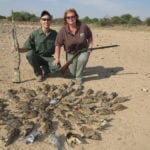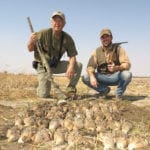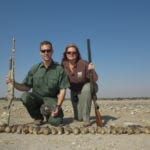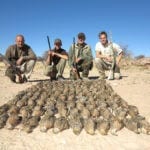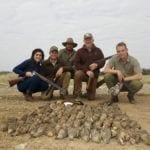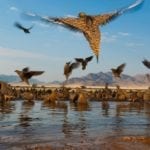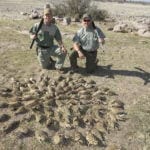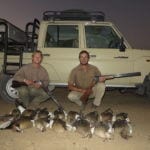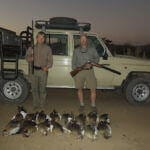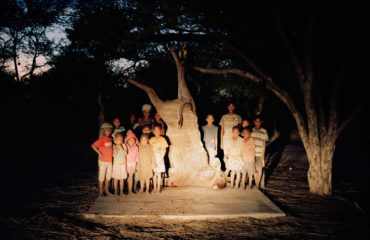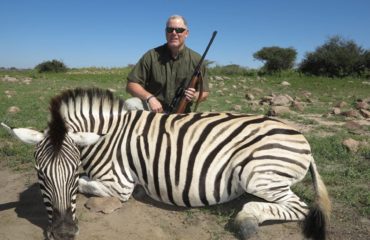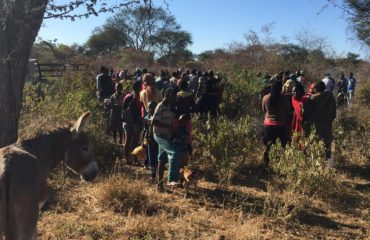A chance meeting in late 2017 with an enthusiastic young person hunting from Namibia led to an awesome Namibia wingshooting trip for six Australians. Although our inquiry originally was about plains game and what options were available, the subject of wing shooting arose and slowly took precedence.
Schalk Pienaar, himself a keen wing shooter, gave us his full attention. His eyes glimmered and gradually turned to a spark as he realized here was an opportunity to add an important dimension to his professional hunting career. It came as no surprise that he knew more than enough to organize a full on bird shooting tour in his country.
Namibia possesses a treasure trove of game to be hunted on pristine wilderness locations. This is a fact that has not been missed by dozens of hunters that land at Windhoek airport every day. What is not fully appreciated is the wealth of game birds that inhabit the dry arid terrain.
My close friend, Ian Head of World Safari Xpeditions put together, – in collaboration with Bird Hunters Namibia, -a seven day program that was to include, Doves, Pigeons, Guinea Fowl, Francolin, Egyptian Geese, and the crème de la crème…… Sandgrouse.
Ian collected six willing bird shooters to make the journey and try out the new program. Three chaps of proud Maltese descent, put their hand up. Two of them had the same name so they were promptly dubbed Charlie 1, and Charlie 2. The Charlie’s and their mate John were very keen bird men, evidenced by their enthusiasm to identify every new ornithological delight they witnessed. Mark, a chopper pilot and businessman; Paul another successful businessman; and Ron, a regular traveler to Africa made up the shooting party. In between helping out with the logistics and taking notes and photos, Ian and I also would try and fit in a shot or two.
Our first stop was a huge cattle feedlot that was experiencing trouble with marauding birds. Such was the extent of the problem, an extra two kilos of fodder per head was needed every day to make up the difference between what the cattle got, and what they required. Do the sums, two kilo multiplied by seven thousand head of cattle is a massive addition to the cost of feed per day. So, whatever our group eliminated was going to help immensely to reduce the feedlots expenses.
The Doves, both Cape and Laughing, and Red Eye Pigeons were in great profusion and provided fantastic fast moving targets. As we had arrived later than planned the Geese had been and gone. There was still the odd one around to provide some high target sport. Mark, Charlie 1, and Paul in particular were all superb shots and averaged over several hours a rate of 70-80% kill per cartridge.
We were taken to a midday break for lunch and rest to a typically African Lodge just down the road, and returned to catch the late afternoon flight of Egyptian Geese. After the speed and jinking of the doves and pigeons the geese tested our ability to deal with the high to very high shots. Additionally, these birds are extremely wary, and would very quickly gain extra height if any movement was detected from the shooters. Weighing around 2kg, a bit more for ganders and a bit less for the female, they consume a considerable amount of food in a day and it was estimated there were 14,000 in the area. Apart from diminishing the flocks the food provided for the local population was highly appreciated.
A trip south to various farm lands was our next destination. Some fantastic hospitality was enjoyed over the following few days at the Lodge as well as very comfortable living quarters.
Thoroughly wild Guinea Fowl were next on our agenda. A large flock would be sighted and the shooters quickly deployed ahead of the birds. Vehicles and staff would then walk upon the birds until they took flight over the shooters. Very exciting stuff; with some excellent high, fast moving birds being taken. In between times we walked, with Guinea’s cackling their raucous staccato call, along dry river beds in search of Francolin. Similar to an oversized Quail, Francolin are prized as a delicious table bird. Most gave us the slip through the thick bush, but a few specimens were taken.
At this stage, there was an opportunity to hunt some plains game. Ron, John, and the two Charlies all bagged some nice trophy animals including Oryx, Warthog and Zebra. Two very good specimens of African Wild Cat were seen in the middle of the day. As a collector of cats, I envied those with a rifle at the ready. With some good taxidermy work in the future, the lads had Africa covered with such a nice sample of game.
The team then moved again to take advantage of what many consider the ultimate wing shooting experience Africa has to offer—-Sandgrouse.
Of all the species of Sandgrouse, Burchells, or Pterocles burchelli, abound in the area while the Namaqua, Pterocles namaqua, are much less prevalent. Sandgrouse are misnamed, as they are not a true grouse, but half way between a grouse and a pigeon. They do however possess the feathered feet and parts of the legs that true grouse have. These wonderful little birds are magnificently adapted to their desert environment, having absorbent breast feathers with which they soak up moisture while drinking, and then carry the resultant water payload back to their nests. Following the trickle then flood of birds over a period of seventy minutes, the males were observed drinking and dipping in one motion, a procedure that only took a few seconds before they took flight back to their desert homes.
The Namaqua in particular, are a very handsome bird, easily identified even in flight, due to the pointed tail feathers. There is no doubt, the man that has one well mounted for his trophy room will own a beautiful piece of bragging rights.
Still, these wonderful little birds, [which are also incredibly good eating] by virtue of their predictable bi-daily drinking regimen, can be extremely vulnerable to over hunting. Several methods of decreasing the danger of over hunting are utilized while further methods are under consideration. Bird Hunters Namibia is determined to leading the charge in Namibia when it comes to initiating these conservation procedures.
Education of shooters before they are in the field is the obvious first initiative. All shooters have it explained to them to aim for the single or double birds and not simply spray the centre of the flock. Skilled shot gunners make this their prerogative. It is after all a gentleman’s pastime, to have a pleasant days sport, and not an exercise in competitive one-upmanship as to who can kill the most birds.
Auto loading shot guns should be summarily disallowed as these firearms encourage shooting the packed flocks. A under/over, or side/side double barreled shot gun is the best tool for the discerning shooter. We had a nice mix of modern U/O, and traditional British SxS guns in our party,
Furthermore, ceasing shooting at the final thirty or so minutes of the flight helps towards over culling and as a further benefit provides the remaining birds access to water before their instinct drives them back to their nest. A restriction on the number of cartridges available to each gun may be effective, so once a shooter has used his allocation, his day ceases.
After the euphoria of Sandgrouse, we travelled with much cheer to a smaller cattle feedlot. The doves here were incessant. Thousands upon thousands pitched in for a free feed. Barrels ran hot. I stopped to take some photographs of Charlie 1, and in the blink of an eye he had 35 doves on the ground. Later, I returned to his position after shooting had finished finding him with a pile of birds, estimated at 450. But, the numbers seemed undiminished although they were no longer landing. Once again, the farmer was deeply obliged for the help in reducing his feed costs.
Back to Windhoek for another crack at the first feedlot we shot over. The evening flight of geese was awesome, with about 400 being bagged. Apart from the reduction in numbers, the remaining geese were very wary, and would more than likely avoid the feedlot for some time.
Sadly, that was the end of a marvelous experience and we all returned to our hotel reluctant to start packing for the trip home. Goodbyes and thanks were passed to Schalk, Hugo, and their team for the super times they conjured on our behalf. As we trudged through the airline portals, talk was all about how and when we could all find time to come for another Namibian Wing Shooting Odyssey.


